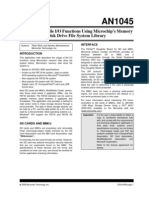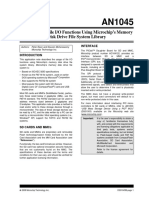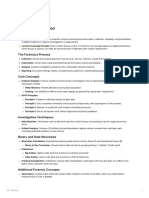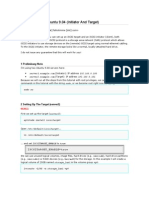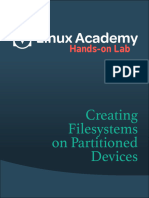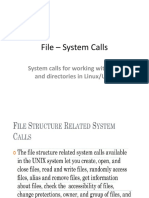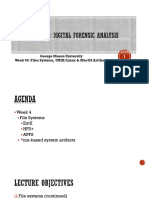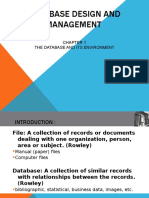Ntfs Cheat Sheets
Ntfs Cheat Sheets
Uploaded by
blahCopyright:
Available Formats
Ntfs Cheat Sheets
Ntfs Cheat Sheets
Uploaded by
blahOriginal Description:
Copyright
Available Formats
Share this document
Did you find this document useful?
Is this content inappropriate?
Copyright:
Available Formats
Ntfs Cheat Sheets
Ntfs Cheat Sheets
Uploaded by
blahCopyright:
Available Formats
NTFS Reference Sheet
NTFS Boot sector
0
1
2
0 Jump Instruction
10
0x000000
unused
6
7
OEM ID
Media
desc
0x0000
B
C
Bytes/ Sector
Sect /
track
D
E
F
Sect/
res
clust
Hidden Sectors
Number
heads
Total Sectors
Logical Cluster of $MFTMirr
Volume Serial Number
Boot Code
20
unused
30
Logical Cluster of $MFT
40 Clust / File record segment
Clusters / Index Block
50
Checksum
60
.
Boot Code
.
.
1E0
1F0
Boot Code
55
AA
Key
Sect / Clust - Sectors per cluster
res - reserved, note that the terms reserved, unused and 0x00 are specified by Microsoft, the difference between reserved and
unused is not specified. However it should be noted that the blocks specified as all zeros have defined meaning within FAT boot
sectors.
media desc - Media descriptor, legacy from DOS, 0xF8 indicates fixed disk, 0xF0 a HD 3.5inch floppy.
BIOS Parameter Block (BPB)
Extended BPB
Boot code
End of sector marker
reference: http://technet.microsoft.com/en-us/library/cc976796.aspx
NTFS files
File
Name
$Mft
Master File Table
$MFT
record #
0
$MftMirr
MFT mirror
$LogFile
Log file
$Volume
Volume
$AttrDef
4
5
The root folder.
$Bitmap
$Boot
Attribute
definitions
Root file name
index
Cluster bitmap
Boot sector
Contains one base file record for each file and folder on an NTFS volume.
If the allocation information for a file or folder is too large to fit within a
single record, other file records are allocated as well.
Guarantees access to the MFT in case of a single-sector failure. It is a
duplicate image of the first four records of the MFT.
Contains information used by NTFS for faster recoverability. The log file is
used by Windows Server 2003 to restore metadata consistency to NTFS
after a system failure. The size of the log file depends on the size of the
volume, but you can increase the size of the log file by using the Chkdsk
command.
Contains information about the volume, such as the volume label and the
volume version.
Lists attribute names, numbers, and descriptions.
6
7
$BadClus
$Secure
$Upcase
Bad cluster file
Security File
Upcase table
8
9
10
$Extend
NTFS extension
file
11
Represents the volume by showing free and unused clusters.
Includes the BPB used to mount the volume and additional bootstrap
loader code used if the volume is bootable.
Contains bad clusters for a volume.
Contains unique security descriptors for all files within a volume.
Converts lowercase characters to matching Unicode uppercase
characters.
Used for various optional extensions such as quotas, reparse point data,
and object identifiers.
Reserved for future use.
12-15
Description
source: http://technet.microsoft.com/en-us/library/cc781134(WS.10).aspx
Michael Wilkinson, This document may be freely distributed provided this notice remains intact
The original is located at http://www.writeblocked.org/
Page 1 of 4
NTFS Reference Sheet
Some $MFT entry attributes
ID
Attribute Type
0x10 Standard Information
0x20 Attribute List
Description
Includes information such as time stamp and link count.
Lists the location of all the attribute records that do not fit in the MFT record.
A repeatable attribute for both long and short file names. The long name of the file can be up to
255 Unicode characters. The short name is the MS-DOS-readable, 8.3, case-insensitive name for
the file. Additional names, or hard links, required by POSIX can be included as additional file
name attributes.
A volume-unique file identifier. Used by the link tracking service. Not all files have object
identifiers.
0x30 File Name
0x40 Object ID
0x50 Security Descriptor
0x60 Volume Name
0x70 Volume Information
Shows information about who owns the file and who can access the file.
Used only in the $Volume system file. Contains the volume label.
Used only in the $Volume system file. Contains the volume version.
Contains file data. NTFS allows multiple data attributes per file. Each file typically has one
0x80 Data
unnamed data attribute. A file can also have one or more named data attributes, each using a
particular syntax.
0x90 Index Root
Used to implement folders and other indexes.
0xA0 Index Allocation
Used to implement folders and other indexes.
0xB0 Bitmap
Used to implement folders and other indexes.
Used for directory junction points and volume mount points. They are also used by file system
0xC0 Reparse Point
filter drivers to mark certain files as special to that driver.
Similar to a data stream, but operations on a logged tool stream are logged to the NTFS log file
0x100 Logged Tool Stream
just like NTFS metadata changes. Used by EFS.
source: http://technet.microsoft.com/en-us/library/cc976808.aspx
File Record Segment Header
Seq no
Update Seq
array offset
st
Hard Link
Count
Update Seq
$LogFile Sequence Number
array size
Flags
Used size of file record Allocated size of file
record
1 attrib
offset
File reference to base file record
Next attrib
MFT Record No
ID
Reserved for update sequence array?
3 default location of update seq array
(size determined by seq size)
Reserved for sequence array?
st
Common location of 1 attrib
Resident Attribute Header
Type ID
Content length
Form code
0x00 = Resident
0x01 = Non resident
Attribute Length
Content
offset
Form
code
name
len
Name
offset
flags
Attrib ID
unused
Flags
0x00FF = Compressed
0x8000 = Sparse
0x4000 = Encrypted
Michael Wilkinson, This document may be freely distributed provided this notice remains intact
The original is located at http://www.writeblocked.org/
Page 2 of 4
NTFS Reference Sheet
Non Resident Attribute Header
Type ID
Attribute Length
Form name
Name
flags
Atrib ID
code
len
offset
Ending virtual cluster number
Size of attribute content
10
Start virtual cluster number
20 Runlist Compression
0x0000
offset
unit size
30
size on disk of attribute content
40 Data runlists
Initialized size of attribute content
Attrib ID starts from zero
Virtual cluster numbers are used when a MFT record is fragmented
$Standard_Information
3
4
5
Date Created*
10
20
30
40
Date MFT record modified
Flags
Max Versions
Owner ID
Security ID
Update Sequence Number
B
C
D
Date Modified
Date Accessed
Version Num
Class ID
Quota Charged
*Time values are in 100 nanoseconds since January 1, 1601 UTC
flags (used for both $Standard_Information and $File_Name
Bit Hex
Meaning
Bit Hex
Meaning
0
0x0001
Read only
8
0x0100
Temporary
1
0x0002
Hidden
9
0x0200
Sparse File
2
0x0004
System
A
0x0400
Reparse Point
3
0x0008
B
0x0800
Compressed
4
0x0010
C
0x1000
Offline
5
0x0020
Archive
D
0x2000
Not Indexed
6
0x0040
Device
E
0x4000
Encrypted
7
0x0080
Normal
F
0x8000
Source: http://msdn.microsoft.com/en-us/library/aa365535(v=VS.85).aspx
$File_Name
0
10
2
3
4
5
Parent Directory
Date Modified
20
Date Accessed
30
Size on disk
40
B
C
D
Date Created
Date MFT Modified
Logical file size
Flags*
Reparse value
Name Name
Name (variable length)
len type
Name types
Value
Description
POSIX (unicode, case sensitive)
Win32 (unicode, case insensitive)
DOS (8.3 ASCII, case insensitive)
Win32 7 DOS (when Win32 fits in DOS space)
Michael Wilkinson, This document may be freely distributed provided this notice remains intact
The original is located at http://www.writeblocked.org/
Page 3 of 4
NTFS Reference Sheet
$Data (Standard Header with data run, may be resident or non resident, non resident shown here)
0
0
10
20
30
40
Type ID
Attribute Length
0x80
Start virtual cluster number
Runlist Compression
0x0000
offset
unit size
size on disk of attribute content
Data runlists
Form name
Name
flags
Atrib ID
code
len
offset
Ending virtual cluster number
Size of attribute content
Initialized size of attribute content
Data runlists
$ATTRIBUTE_LIST entry (one entry per attribute in the record, including attributes that precede the list).
Type ID
Record
Length
$MFT Record number
Atrib Attrib
name name
len offset
Seq num
Lowest VCN
Reserved
Start of name (if present)
Source: http://msdn.microsoft.com/en-us/library/bb470038%28v=vs.85%29.aspx
Michael Wilkinson, This document may be freely distributed provided this notice remains intact
The original is located at http://www.writeblocked.org/
Page 4 of 4
You might also like
- Mastering Malware Analysis: A malware analyst's practical guide to combating malicious software, APT, cybercrime, and IoT attacksFrom EverandMastering Malware Analysis: A malware analyst's practical guide to combating malicious software, APT, cybercrime, and IoT attacksRating: 4.5 out of 5 stars4.5/5 (1)
- Creating and Managing Virtual Machines and Networks Through Microsoft Azure Services for Remote Access ConnectionFrom EverandCreating and Managing Virtual Machines and Networks Through Microsoft Azure Services for Remote Access ConnectionNo ratings yet
- Fixing Common Computer Problems: A Comprehensive Troubleshooting GuideFrom EverandFixing Common Computer Problems: A Comprehensive Troubleshooting GuideNo ratings yet
- Computer Forensics: NTFS File SystemDocument42 pagesComputer Forensics: NTFS File SystemLars BjorkNo ratings yet
- FAT1Document35 pagesFAT1gigicalteaNo ratings yet
- Hard Drive Partitioning KnowledgeDocument222 pagesHard Drive Partitioning KnowledgeYazan Maswadeh100% (1)
- File IO Functions Using Microchip's Disk Drive File SystemDocument44 pagesFile IO Functions Using Microchip's Disk Drive File Systemlololo1213No ratings yet
- AN1045 - Implementing File I-O Functions Using Microchip's Memory Disk Drive File System LibraryDocument44 pagesAN1045 - Implementing File I-O Functions Using Microchip's Memory Disk Drive File System Libraryfrank_grimesNo ratings yet
- NTFS Structure: Excellent ReferenceDocument64 pagesNTFS Structure: Excellent ReferenceSyeda Ashifa Ashrafi PapiaNo ratings yet
- Extensible File Allocation Table (ExFAT) AHTCC V1.1Document117 pagesExtensible File Allocation Table (ExFAT) AHTCC V1.1zoraniliNo ratings yet
- OS Forensics NotesDocument29 pagesOS Forensics Notesalexkunwar9817No ratings yet
- Xbox360 File ReferenceDocument13 pagesXbox360 File Referencejotaryn777No ratings yet
- FAT Partition Boot SectorDocument28 pagesFAT Partition Boot Sectordenis palacNo ratings yet
- LAB4 SharadDocument4 pagesLAB4 Sharadpandeysharad2002No ratings yet
- Flash Block StructureDocument7 pagesFlash Block Structuregongjinjun10No ratings yet
- Windows Compound Binary File Format SpecificationDocument9 pagesWindows Compound Binary File Format Specificationnumeprenume1981No ratings yet
- Week2 Windowsfs PDFDocument6 pagesWeek2 Windowsfs PDFMostafa HezoNo ratings yet
- 2 (1) (1) - File SystemDocument7 pages2 (1) (1) - File SystemChinu RaoNo ratings yet
- Yamaha PSR-9000 File FormatsDocument24 pagesYamaha PSR-9000 File FormatsJuan Luis Rojas SaleguiNo ratings yet
- Fat FilesDocument37 pagesFat FilesNobin MathewNo ratings yet
- Ntfs and FatDocument44 pagesNtfs and FatamitzagadeNo ratings yet
- CNS 320 Week10 Final ReviewDocument94 pagesCNS 320 Week10 Final Reviewalb3rtlinNo ratings yet
- Sector Hard Disk Boot Random Access Memory PartitionDocument4 pagesSector Hard Disk Boot Random Access Memory PartitionVickyNo ratings yet
- App-V File Format v1Document60 pagesApp-V File Format v1surkal100% (2)
- Giu 2623 64 20035 2024-10-10T12 02 37Document38 pagesGiu 2623 64 20035 2024-10-10T12 02 37mohandayman2002No ratings yet
- Operating Systems Development Series Bootloaders 4Document9 pagesOperating Systems Development Series Bootloaders 4Sandeep RoyNo ratings yet
- Mac OSMetadataDocument11 pagesMac OSMetadatajminnihanNo ratings yet
- S2800 - S3000 - S3200 MIDI System Rxclusive ExtensionsDocument35 pagesS2800 - S3000 - S3200 MIDI System Rxclusive ExtensionspepeperdonesNo ratings yet
- The little filesystem technical specificationDocument7 pagesThe little filesystem technical specificationlilyjobhopNo ratings yet
- Stat CommandDocument3 pagesStat CommandDarkoNo ratings yet
- PSR-9000 File Formats PDFDocument24 pagesPSR-9000 File Formats PDFAnonymous HGOomkn69No ratings yet
- Divyanshu Joshi DosDocument22 pagesDivyanshu Joshi DosDivyanshu joshiNo ratings yet
- Examining The Fat File SystemDocument22 pagesExamining The Fat File SystemKasi ChinnaNo ratings yet
- NTFS CHEETSHEET - SwastikDocument57 pagesNTFS CHEETSHEET - SwastikswastiNo ratings yet
- Week 3 File SystemsDocument22 pagesWeek 3 File Systemsbacofe4661No ratings yet
- Portable Executable FormatDocument18 pagesPortable Executable FormatJefrey Sobreira SantosNo ratings yet
- FAT CheatsheetDocument3 pagesFAT CheatsheetmsquireNo ratings yet
- Moabi - Witchcraft-Compiler-Collection User ManualDocument47 pagesMoabi - Witchcraft-Compiler-Collection User ManualMoabiNo ratings yet
- Bncsc501 Set-2 Model AnswerDocument6 pagesBncsc501 Set-2 Model AnswerShreejit SahaNo ratings yet
- Understanding The FAT32 File SystemDocument6 pagesUnderstanding The FAT32 File SystemvirpulimeenNo ratings yet
- LINUX File System: Slides Adopted FromDocument41 pagesLINUX File System: Slides Adopted FromJordan Zu'biNo ratings yet
- ŽŽ FATDocument47 pagesŽŽ FATIxyNeleNo ratings yet
- Using iSCSI On Ubuntu 9Document9 pagesUsing iSCSI On Ubuntu 9xzeppocorexNo ratings yet
- Hands-On Lab Creating Filesystems On Partitioned DevicesDocument10 pagesHands-On Lab Creating Filesystems On Partitioned DevicesIyyappan ManiNo ratings yet
- Dis 8051Document38 pagesDis 8051iasudiNo ratings yet
- RegistryDocument27 pagesRegistryDanijela MijailovicNo ratings yet
- Windows Artifacts Dissected by Mike MurrDocument43 pagesWindows Artifacts Dissected by Mike MurrJennifer HansenNo ratings yet
- The FAT File System: Cluster Directory File Allocation TableDocument10 pagesThe FAT File System: Cluster Directory File Allocation TableBruhath KotamrajuNo ratings yet
- UnixDocument2 pagesUnixsubbuk143No ratings yet
- CFOR 101 Computer Forensics I Lab Package # 3 Understanding File Systems - FATDocument17 pagesCFOR 101 Computer Forensics I Lab Package # 3 Understanding File Systems - FATUly BeatzNo ratings yet
- MFT StructuresDocument68 pagesMFT Structureskacos2000No ratings yet
- File - System CallsDocument32 pagesFile - System Callsballe balleNo ratings yet
- DFOR510 Week04 FileSys NixDocument26 pagesDFOR510 Week04 FileSys NixDA MVNo ratings yet
- Files and File Systems: File Storage Structure File System Implementation Kernel Abstraction Communication Through A PipeDocument25 pagesFiles and File Systems: File Storage Structure File System Implementation Kernel Abstraction Communication Through A PipePrincy GuptaNo ratings yet
- (InfoAcademy) CyberOpsAssociate-Sedinta13Document34 pages(InfoAcademy) CyberOpsAssociate-Sedinta13Chip CiprianNo ratings yet
- Chapters-Project Report FinalDocument58 pagesChapters-Project Report FinalGarima JainNo ratings yet
- EnCase Forensic Imager v7.09 User's GuideDocument35 pagesEnCase Forensic Imager v7.09 User's GuideAlberto PerezNo ratings yet
- Hbase MaprDocument25 pagesHbase MaprMohsin NoorNo ratings yet
- File-System Interface: Silberschatz, Galvin and Gagne ©2018 Operating System Concepts - 10 EditionDocument46 pagesFile-System Interface: Silberschatz, Galvin and Gagne ©2018 Operating System Concepts - 10 EditiontHe tecHniquEsNo ratings yet
- Unit 1 Computer: Evolution and DevelopmentDocument34 pagesUnit 1 Computer: Evolution and DevelopmentGRAVES JAKENo ratings yet
- 18csc203j - Coa Unit 1Document25 pages18csc203j - Coa Unit 1Rishabh ShahNo ratings yet
- Qradar StorageDocument1 pageQradar StorageghhhghNo ratings yet
- MT6735 Android ScatterDocument7 pagesMT6735 Android ScatterAdán Salinas ArayaNo ratings yet
- MTVL043Document2 pagesMTVL043deepakkr22781No ratings yet
- MSMQBest PracticeDocument23 pagesMSMQBest Practicecaiofelipe123No ratings yet
- Web Technology (Chapter - Website Design) Solved MCQs (Set-1) PDFDocument6 pagesWeb Technology (Chapter - Website Design) Solved MCQs (Set-1) PDFDINESHWARAN MNo ratings yet
- Database Design and ManagementDocument45 pagesDatabase Design and ManagementJeneath TahilNo ratings yet
- CS NotezDocument207 pagesCS Notezcollins chinsungweNo ratings yet
- Hard Disk Drive Destruction Devices: NSA/CSS Evaluated Products List ForDocument4 pagesHard Disk Drive Destruction Devices: NSA/CSS Evaluated Products List Forgearhead1No ratings yet
- Final Exam in Mil 2023Document3 pagesFinal Exam in Mil 2023APRIL ROSE VICENTENo ratings yet
- q2 Chs Remedial ActivityDocument1 pageq2 Chs Remedial ActivityJeneviev QuintalNo ratings yet
- Troubleshooting Guide CMDB 7.6.04Document204 pagesTroubleshooting Guide CMDB 7.6.04maps1301No ratings yet
- Computer Whiz TG 7 4th EdDocument54 pagesComputer Whiz TG 7 4th EdAli Arsh KhanNo ratings yet
- Prodesk 6Xx SFF Series: Interactive System Board ViewerDocument19 pagesProdesk 6Xx SFF Series: Interactive System Board ViewerolidyverNo ratings yet
- 653f504d49732cyber Security Unit 4Document30 pages653f504d49732cyber Security Unit 4Vanshika SharmaNo ratings yet
- Sow 2023-2024 Y10 IctDocument7 pagesSow 2023-2024 Y10 IctIce Syah100% (1)
- Front Office NC2 CBC From TESDADocument96 pagesFront Office NC2 CBC From TESDAGina Labor Obierna50% (2)
- IMD113 - Cp1 - Introduction To ComputersDocument61 pagesIMD113 - Cp1 - Introduction To Computersnur hazirahNo ratings yet
- Dell Emc Storage ProductsDocument4 pagesDell Emc Storage ProductsS C CharlesNo ratings yet
- Harvard ArchitectureDocument3 pagesHarvard Architecturebalu4allNo ratings yet
- EFM8 Busy Bee Family EFM8BB1 Reference ManualDocument231 pagesEFM8 Busy Bee Family EFM8BB1 Reference ManualFrancesco MenichelliNo ratings yet
- Department of Information Technology Sreenidhi Institute of Science and TechnologyDocument4 pagesDepartment of Information Technology Sreenidhi Institute of Science and TechnologyRuksana MohammadNo ratings yet
- BCA Paper-V Unit-10Document15 pagesBCA Paper-V Unit-10nagaNo ratings yet
- Cse IV Computer Organization (10cs46) NotesDocument214 pagesCse IV Computer Organization (10cs46) NotesRajesh KannaNo ratings yet
- Me2401 Mechatronics - 2 Marks With Answer PDFDocument15 pagesMe2401 Mechatronics - 2 Marks With Answer PDFSiva RamanNo ratings yet











